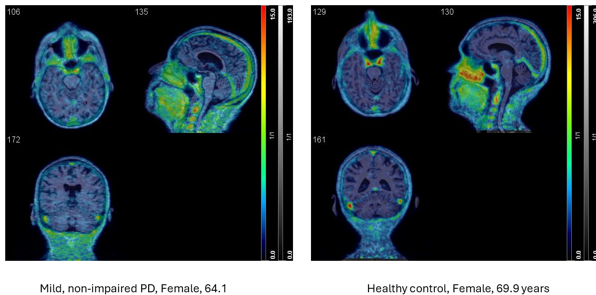Key details
Untangling protein structure to treat neurodegenerative disorders
Devastating neurodegenerative diseases such as Dementia with Lewy Bodies (DLB), Parkinson’s disease (PD) and Multiple System Atrophy (MSA), are characterised by the widespread accumulation of an aggregated protein, alpha-synuclein (αSyn), in the brain. Scientists believe that the clusters of αSyn and/or the mechanisms leading to their formation, may be important in the progress of these diseases.
It is unclear how or why these proteins begin to clump together but identifying the mechanism could lead to therapeutics that may slow or halt the process. Dr Tim Bartels is one of the researchers investigating this topic, trying to understand how αSyn folds into various structural forms. In his recent work, he found that αSyn normally exists in a helical structure which is resistant to aggregation. If the protein can be stabilised in this form, it may not clump together into the harmful aggregates observed in disease.
Furthermore, the Bartels Lab will utilise donated brain tissue from Queen Square Brain Bank for Neurological Disorders (QSBB) which holds a unique archive of brains and tissue donated by individuals with neurodegenerative disease, and healthy brains for comparison. Validating the existence of diverse structural configurations of αSyn in people with the disease, as well as animal models, will be critical to developing treatments for these disorders.
Latest news



Dr Tim Bartels
Dr Tim Bartels is a Group Leader at the UK DRI at UCL. Find out more about his career and expertise on his profile page.

Research summary

Using an advanced preparative Seeded Amplification Assay, the Bartels lab in collaboration with WuXi AppTec was able to screen a 60 million compound library for small molecules binding specifically PD brain derived fibrils. Hit compounds showed no crossreactivity binding to tau, abeta or synthetic synuclein fibrils. The picture shows early data of an experimental PET tracer derivative of one of the hits, developed by the Bartels / Wang / Goemperts / Khurana lab (UCL/Harvard Medical School)
Structure-function relationship in neurodegeneration
The Bartels Lab is part of the UK Dementia Research Institute, where its research delves into the molecular foundations of neurodegenerative diseases. Specifically, the group focus on “synucleinopathies,” which include Parkinson’s disease, multiple system atrophy, and Lewy body dementias. The main culprit in these disorders appears to be the protein alpha-synuclein. This small neuronal protein is widely produced throughout the brain for our entire lives, but in a subset of the elderly population, it malfunctions in specific brain regions, leading to the distinct clinical manifestations of synucleinopathies.
Despite over 25 years of research, the mechanisms that trigger alpha-synuclein's transition from a normal to a pathological state, and the factors that determine the brain’s varying susceptibility to this dysfunction, remain elusive. The Bartels Lab aims to unravel these mysteries.
Dr Bartels has observed that translating basic research into clinically meaningful treatments and diagnostics is still a challenge. Therefore, the approach of his team begins with examining human tissue, currently in collaboration with Zane Jaunmuktane at the renowned Queen Square Brain Bank or Rimona Weil at the Dementia Research Centre at UCL. From there, the group delves deeper into modelling to understand and potentially correct what it observe in patients, as evidenced by its recent publications that were funded under its QQ1 UK DRI programme.
As a question-driven lab, it employ a range of cutting-edge technologies (like human stem cell-derived neuronal models and advanced structural biology methods) based on the specific mechanisms it is studying. For example, to investigate tissue region specificity, the interaction between the peripheral and central nervous systems, or the interplay between different cell types, animal models are invaluable for elucidating disease-relevant mechanisms and is the target of the team's current QQ2 UK DRI programme focussing on the gut-brain axis in Parkinson’s Disease.
The Bartels Lab operates on a global scale, recognizing that the comprehensive expertise required for these holistic studies necessitates collaboration with specialists from around the world. It participates in extensive, multi-lab projects with collaborators from the USA, mainland Europe, the UK, and within the DRI.
Given its proficiency in analysing human tissue and replicating disease-relevant molecules in vitro, it also maintains strong collaborations with the pharmaceutical and biotech industries. It provides novel experimental assays, disease expertise, and calibrators for drug development efforts. Simultaneously, it strives to strengthen its partnerships with clinical colleagues to ensure its work translates into tangible benefits for patients.
The video shows lightsheet microscopy of a whole cleared mouse brain stained for protein alpha-synuclein tagged with GFP expressed under the endogenous synuclein promotor (Knock-In mouse model generously provided by Kelvin Luk). Credit: Bartels Lab
Key publications
Vacancies
Lab members
- Dr Qing Wang (Postdoctoral Researcher)
- Dr Ahmed Soliman (Postdoctoral Researcher)
- Dr James Conway (Postdoctoral Researcher)
- Marta DiFabrizio (Postdoctoral Researcher)
- Jiajing Guan (Research Technician)
- Marisa Edmonds (Research Technician)
- Amber Wallis (Research Lab Manager)
- Viktoria Klein (PhD Student)
- Yee Goh (PhD Student)
- Maria Yudina (PhD Student - joint with Dr Soyon Hong)
- Lily Bowen (MSc Student)
- Zeinab Sayagh (Visiting Student)
- Aleyna Nur Erim (Visiting Student)
- Angela Amador Benitez (Visiting Research Assistant)
- Lenart Senicar (Technician)
- Laura De Boni (Senior Researcher)
- Paula Alconchel Albelda (Student)
- Harry Lau (PhD Student)
- Ayan Mukherjee (Technican)
- Rachel Mahoney (Student)

The Bartels Lab
Collaborators













Lab funders
Thank you to all those who support the Bartels Lab!



